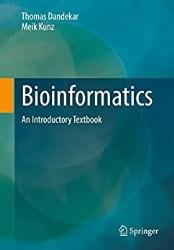Bioinformatics: An Introductory Textbook
- Добавил: literator
- Дата: 8-03-2023, 01:46
- Комментариев: 0
 Название: Bioinformatics: An Introductory Textbook
Название: Bioinformatics: An Introductory TextbookАвтор: Thomas Dandekar, Meik Kunz
Издательство: Springer
Год: 2023
Страниц: 354
Язык: английский
Формат: pdf (true)
Размер: 13.5 MB
This book offers a gripping introduction to the fastest growing field of biology with easy-to-follow examples and a well-prepared appendix for the reader to cook up and experience everything right away.
The book gets the reader started with the basics, such as how to easily find sequence information and then analyze it. In further chapters, the authors go into the various analysis options from RNA, DNA and proteins to entire metabolic pathways. Exciting examples from biology are chosen in each chapter to illustrate the analysis. Each chapter concludes with an exercise section that immediately puts what has been learned to use.
The subject of this book is a must for any biology student, whether undergraduate or graduate, as bioinformatics is now unearthing amazing insights into the molecular basis of all living things. Computer Science students and other students from related sciences will get a good introduction to bioinformatics, as biology and current topics (e.g. Artificial Intelligence (AI)) are systematically introduced step by step alongside the software.
For students who enjoy programming, appropriate references for further reading are given in the introduction to the tutorials. Since bioinformatics lives on databases and software, we have summarized databases and programs and their basic use in the chapters and in the appendix.
Perl (Practical Extraction and Report Language): This programming language is very popular in bioinformatics because it is very good for processing long lists and compiling them into new lists. To be able to program faster in PERL yourself, there are also the BioPerl modules.
Java: This programming language by James Gosling (1991) runs on every major operating system (“platform”, Windows, Mac and LINUX) and is so popular because you can write it once and then run it (especially over the Internet) on any platform. It is an object-oriented, modern programming language, so “objects” as complex concepts are central to it. Java‘s syntax is similar to C or C++, but Java‘s comfortable, high level language does not make it as easy to refer to single bit instructions (the machine language) as it is with C or C++. Here, too, there is Biojava, i.e. ready-made program modules for bioinformatics.
As soon as more complex calculations are the focus (instead of lists, data, web servers, databases or sequence properties), more languages such as C or C++ (computer languages that are also used intensively and developed further today, newer is e.g. C#, pronounced: C Sharp, and similar more) and Fortran (Formula Translation) are used in bioinformatics, old but constantly modernised. For example, Fortran 2003 is object-oriented, and Fortran 2008 even allows “concurrent programming”, i.e. parallel, instead of serial programming.
MATLAB: Allows complex computations to be efficiently expressed in this language in a mathematical way. MATLAB is matrix-based. Linear algebra in MATLAB looks like linear algebra in a textbook. This makes the code for these calculations easier to write, read, and analyze, and easy to manage. Numerical analyses are also easy to write. Another advantage is that computations are distributed across multiple processors (“cores”), making them much faster. This makes parallelization easy.
Programming Language R: If, on the other hand, the calculations are of a more statistical nature, i.e. deal directly with the analysis of large amounts of data, R is often used in bioinformatics. R is also very easy to learn by following the link, installing R right there and learning it too. R is freely available and very useful for statistical analysis and graphical representation of biological data (results and graphs can also be used for scientific publications). It is command line based and can be used on different platforms and operating systems (e.g. Windows, Linux). In short, R is a really nice and easy to learn programming language, best try it yourself (there are also numerous online codes to use). Moreover, it is interconnected with other programming languages and platforms, such as Bioconductor, for even more specialized data analysis.
Скачать Bioinformatics: An Introductory Textbook
[related-news] [/related-news]
Внимание
Уважаемый посетитель, Вы зашли на сайт как незарегистрированный пользователь.
Мы рекомендуем Вам зарегистрироваться либо войти на сайт под своим именем.
Уважаемый посетитель, Вы зашли на сайт как незарегистрированный пользователь.
Мы рекомендуем Вам зарегистрироваться либо войти на сайт под своим именем.
